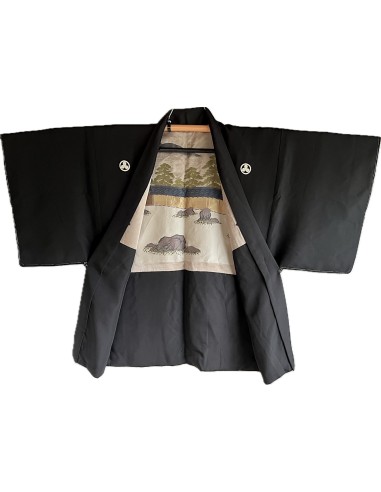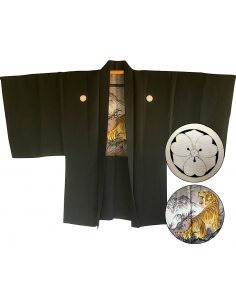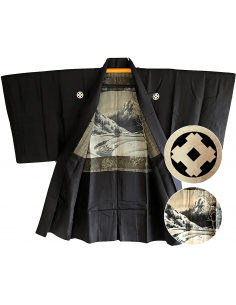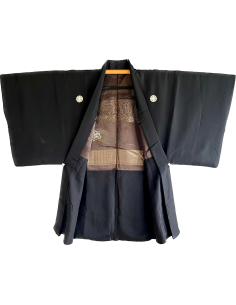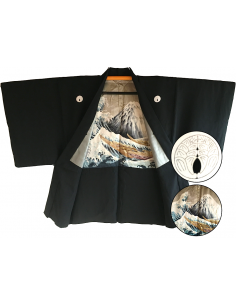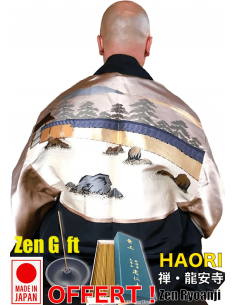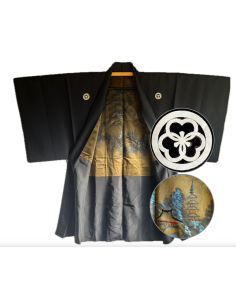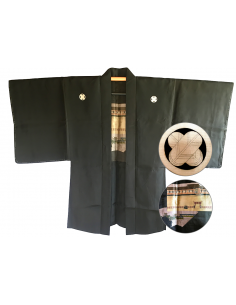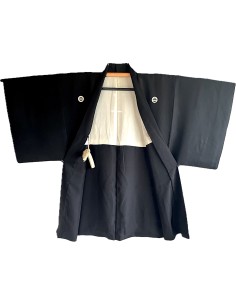Luxury Black Silk Men's Haori - Mitsu Kashiwa Crest - Ryoanji
Discover this rare antique men's haori in black silk, adorned with the Mitsu Kashiwa crest. Inspired by Kyoto's Zen garden, it blends elegance with tradition. Perfect for display or wear.
Rare Antique Zen Ryoanji Haori for Men
Origin: Made in Japan
Material: 100% pure black silk
Lining: Gold silk
Kamon: Adorned with 5 Mitsu Kashiwa family crests
Meaning of the Mitsu Kashiwa Kamon
The Mitsu Kashiwa represents three stylized oak leaves gathered at the center. The oak, a symbol of strength and longevity in Japan, underscores familial or clan strength. The circle surrounding the leaves signifies unity and protection, indicating a firmly united and protected clan.
The Samurai Clan that Wore This Kamon
The Mitsu Kashiwa emblem was used by several clans, including the Kashiwa clan and certain branches of the Tokugawa clan. These respected warriors used this symbol to represent their strength, longevity, and loyalty to their lord.
Pattern: Quilted design representing the dry Zen garden of the famous Ryoanji Temple in Kyoto.
Dimensions:
- Height: 90 cm
- Shoulder Width: 60 cm
- Sleeve Width: 33.5 cm
- Sleeve Height: 49 cm
- Arm Span: 130 cm
Period: Heisei (1989~)
Condition: Excellent, like new (see detailed photos)
Description:
Unique, rare, and beautiful antique Haori in high-quality silk. Ideal for displaying in your home or wearing over a kimono, samue, or iaidoGi for Kenjutsu practice or other martial arts. Also pairs well with traditional or modern clothing.
Shipping:
This Haori will be shipped exclusively via DHL EXPRESS (4 to 7 days) to ensure perfect delivery.
Zen Japanese Garden of Ryoanji Temple
Ryōan-ji (龍安寺, literally "Temple of the Dragon's Peace") is a Zen temple located in northwest Kyōto, built in the 16th century, and is part of the UNESCO World Heritage. The famous karesansui rock garden of Ryōan-ji is considered a masterpiece of Japanese Zen culture.
The Rock Garden
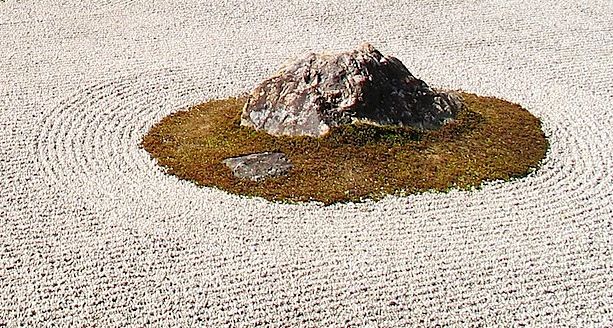
The garden was built in the late 15th century or early 16th century, between 1499 and 1507. It covers an area of approximately 200 square meters. It is surrounded to the south and west by a roofed stone wall, to the east by another wall, and to the north by a wooden veranda behind which is the hōjō (the temple superior's quarters).
Outside are Japanese maples and red pines that were likely not present originally. The construction on a flat site is a novelty for the time. Fifteen stones, surrounded by moss, are arranged in groups, from east to west, in groups of five, two, three, two, and three.
The small number of stones is also a novelty compared to other dry gardens of the same period: the Daisen-in garden, for example, has more than a hundred on an area twice as small. The Ryōan-ji rock garden belongs to the category of "void gardens" (mutei).
The stones are arranged so that it is impossible to see all fifteen stones at once from any observer's viewpoint.
The garden consists simply of a bed of fine kaolin gravel artistically raked. The raked kaolin symbolizes the ocean, while the rocks represent mountains.
You might also like

